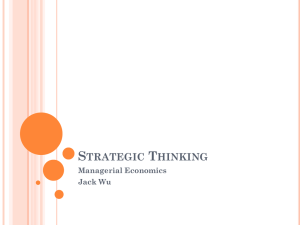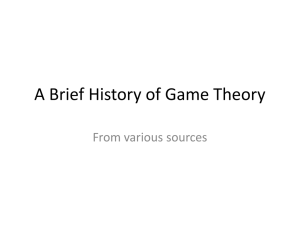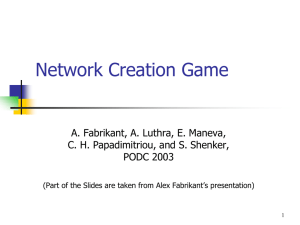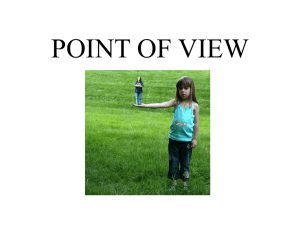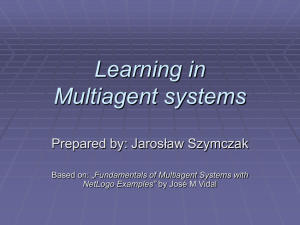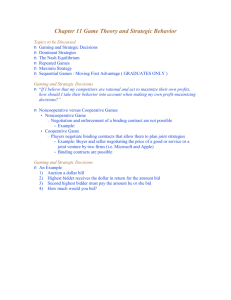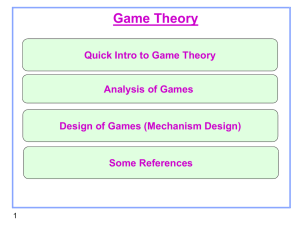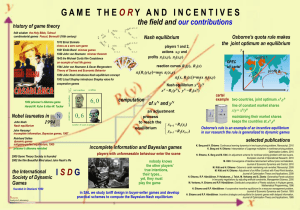IMBA Managerial Economics Lecture Ten Fall 2014
advertisement
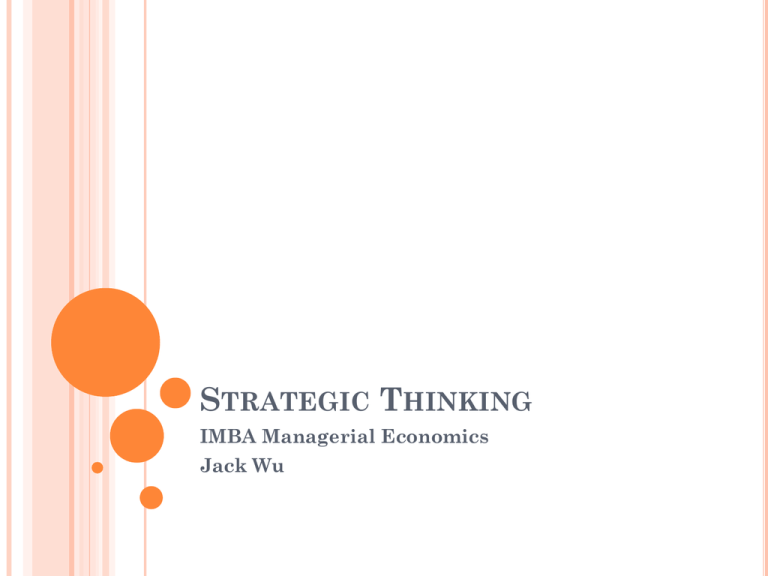
STRATEGIC THINKING IMBA Managerial Economics Jack Wu COKE VS. PEPSI, 1999 Nov. 16: Coca-Cola raised price 7% Nov. 22: Pepsi raised price 6.9% “Coke and Pepsi will move now from price-based competition to marketingbased competition”, Andrew Conway, Morgan Stanley COMPETITIVE DILEMMA Pepsi Raise price Discount Raise price Coke C: 3, P: 3 Discount C: 5, P: 0 What should Coke do? C: 0, P: 5 C: 1, P: 1 STRATEGIC SITUATIONS parties actively consider the interactions with one another in making decisions game theory -- set of ideas and principles to guide strategic thinking simultaneous actions: strategic form sequential actions: extensive form DOMINATED STRATEGY generates worse consequences than another strategy, regardless of the choices of the other parties never use dominated strategy NASH EQUILIBRIUM Given that the other players choose their Nash equilibrium strategies, each party prefers its own Nash equilibrium strategy • No one is willing to deviate unilaterally from a Nash equilibrium SOLVING FOR NASH EQUILIBRIUM eliminate dominated strategies, then check remaining cells “arrow” technique NASH EQUILIBRIUM: COMPETITIVE DILEMMA Pepsi Raise price Raise price Coke What Discount C: 3, P: 3 C: 5, P: 0 should Coke do? Discount C: 0, P: 5 C: 1, P: 1 COKE AND PEPSI GAME Nash equilibrium: for both parties, “raise price” is dominated by “discount”. but discounting is bad for both -- if only they could agree somehow to raise price. Coke and Pepsi stuck in this situation for four years until November 1999. RADIO FORMATS Merkur Lite AC no change Hot AC J: 60, M: 40 J: 60, M: 40 no change J: 70, M: 30 J: 50, M: 50 Jupiter RADIO FORMATS For Merkur, “Lite AC” is dominated by “no change”; so consider only “no change”, assuming Merkur chooses “no change”, Jupiter should choose “Hot AC”. Repeat using “arrow technique”. NASH EQUILIBRIUM: RADIO FORMATS Merkur Lite AC Hot AC Jupiter no change J: 60, M: 40 J: 70, M: 30 no change J: 60, M: 40 J: 50, M: 50 NASH EQUILIBRIUM: PRISONERS’ DILEMMA Sam Do not confess Ian Do not confess Confess What I: 0, S: 0 I: 0, S: -10 should Sam do? Confess I: -10, S: 0 I: -5, S: -5 OPEC: OIL CARTEL June 1998: Saudi Oil Minister Naimi, “I don’t think anybody expects 100% compliance… Once the price goes up, there will be cheating” March 1999: Algerian Oil Minister Youcef Yousfi, “OPEC is still able to act collectively and restore market stability” OUT OF NASH EQUILIBRIUM What if another player doesn’t play Nash equilibrium strategy? Nash equilibrium strategy may not be best still don’t use dominated strategy WHERE TO ADVERTISE? Competitor.com NBA We.com NHL NBA W: 4, C: 3 W: 3, C: 4 NHL W: 3, C: 4 W: 4, C: 3 No Nash equilibrium in pure strategies RANDOMIZED STRATEGIES choose among pure strategies according to probabilities must be unpredictable Example: where to advertise _ We.com: ½ NBA and ½ NHL _ Competitor.com: ½ NBA and ½ NHL RANDOMIZED STRATEGIES: RETAIL PRICE COMPETITION Two competing retailers – Jaya and Ming Three segments captive (loyal) to Ming captive (loyal) to Jaya switchers RANDOMIZED STRATEGIES: RETAIL PRICE COMPETITION Ming High price High price J: 60, Jaya M: 40 Low price J: 50, M: 40 Low price J: 40, M: 50 J: 50, M: 30 RANDOMIZED STRATEGIES: RETAIL PRICE COMPETITION Pricing trade-off: high price to extract buyer surplus of loyal customers low price to get store switchers Solution: randomized discounts COORDINATION/COMPETITION: EVENING NEWS Delta 7.30pm 7.30pm Zeta 8.00pm A: 1, B: 1 A: 4, B: 3 8.00pm A: 3, B: 4 A: 2.5, B: 2.5 COORDINATION AND COMPETITION Prime time for news is 8:0pm; second best is 7:30pm; since audience is limited, get maximum viewership if two channels schedule at different times. Question: which station gets 8:0pm? Situation has elements of coordination -- avoiding same time slot competition -- getting the 8:0pm slot ZERO/POSITIVE SUM zero-sum games: pure competition -- one party better off only if other is worse off positive-sum games: coordination -- both can be better off or both worse off co-opetition: competition and coordination COORDINATION/COMPETITION: INSTANT MESSAGING TECHNOLOGIES Venus Inc. Orange Orange S: 1.5 Sol Corp. Green S: 1 V: 1.5 Green S: 1 V: 1 S: 1.5 V: 1 V: 1.5 COORDINATION/COMPETITION: FUTURE DVD STANDARD Consumers Blu-ray DVD player manufacturers Blu-ray HD-DVD M: 1, C: 1 M: -1, C: -1 HD-DVD M: -1, C: -1 M: 1, C: 1 COORDINATION/COMPETITION: FOCAL POINT Single Nash equilibrium - clear focal point Multiple Nash equilibria - look for focal point to see which one to play SEQUENCING Game in extensive form – sequence of moves: nodes branches outcomes EXTENSIVE FORM: EQUILIBRIUM backward induction final nodes intermediate nodes initial node SEQUENCING: EXTENSIVE FORM - TV NEWS STRATEGIC MOVE Action to influence beliefs or actions of other parties in a favorable way • credibility first mover advantage – second mover advantage – EXAMPLES Examples: Evening TV news -- both stations want to move first: which one can? Use strategic move, eg, contracts with advertisers to deliver news at 8pm. Famous Chinese general: after crossing a river, burnt his ships -- strategic move to force soldiers to fight harder. Issue: Is the move credible? Will it convince the other players? Advantage doesn’t always go to first mover; In war, better to see opponent’s move, and then take action, eg is enemy moving south or north? new product category -- let competitor test the market and educate the customers LITHOGRAPHER Make more prints Buy Make prints consumer Litho Do not Do not Litho Do not (1) serial number (2) destroying the plate (3) other solution? CONDITIONAL STRATEGIC MOVES Threats – if it succeeds, then it needn’t be carried out Promises – if it succeeds, then it needn’t be carried out Ideal strategic move doesn’t impose costs MORGAN STANLEY: “SHAREHOLDER RIGHTS PLAN” If any party acquires 10% or more of company’s shares, other shareholders get right to buy additional shares at 50% discount. Impact on hostile bidder? SHAREHOLDER RIGHTS PLAN This shareholder rights plan is a threat to potential bidders: most hostile bidders begin with small stake; with shareholder rights plan, if bidder acquires more than 15%, then rights triggered, and bidder will be diluted. Nickname: poison pill. Actually works against shareholder rights -- by entrenching existing management. POISON PILL activates rights acquires 100,000 shares Hilda Sharon does not doesn’t bid Hilda loses on initial stake + cost of takeover rises STRIKE reject union demand Employer strike Lose current wage and possibly gain in future wage do not Maintain current wage Union accept Why are strikes rare in American professional football? CONDITIONAL STRATEGIC MOVE: WITHOUT DEPOSIT INSURANCE depositor bank remains solvent maintains deposit depositor withdraws deposit principal + interest bank insolvent zero bank remains solvent principal bank insolvent principal CONDITIONAL STRATEGIC MOVE: WITH DEPOSIT INSURANCE depositor bank remains solvent maintains deposit depositor withdraws deposit principal + interest bank insolvent principal bank remains solvent principal bank insolvent principal
